




placename:- Lancastre
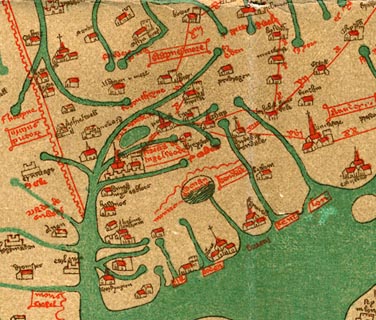 click to enlarge
click to enlargeGgh1Cm.jpg
item:- JandMN : 33
Image © see bottom of page
placename:- Lancastre
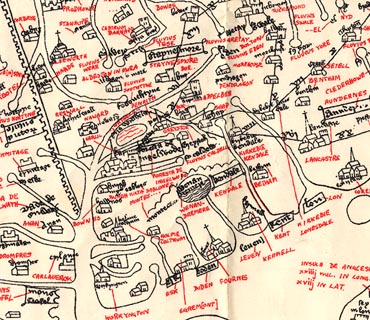 click to enlarge
click to enlargeGgh2Cm.jpg
item:- JandMN : 34
Image © see bottom of page
placename:- Lancaster
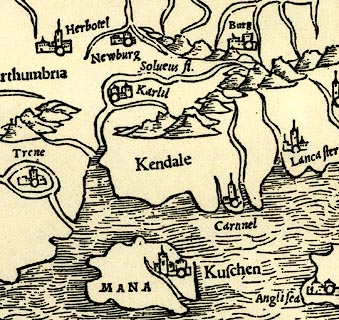 click to enlarge
click to enlargePTY4Cm.jpg
"Lancaster"
circle, buildings, twoer; town
item:- private collection : 131
Image © see bottom of page
placename:- Lancaster
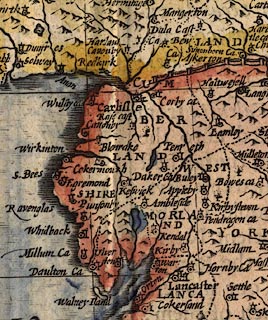 click to enlarge
click to enlargeSPD6Cm.jpg
"Lancaster"
dot, circle, buildings and towers
item:- private collection : 85
Image © see bottom of page
placename:- Luncaster
item:- placename, Lancaster
 goto source
goto sourcepage 162:- "...
... Lun ...
... christning in her Course a Countie Palatine,
For Luncaster so nam'd; the Fort upon the Lun,
And Lancashire the name from Lancaster begun:
Yet though she be a Flood, such glory that doth gaine,
In that the British Crowne doth to her state pertaine,
..."
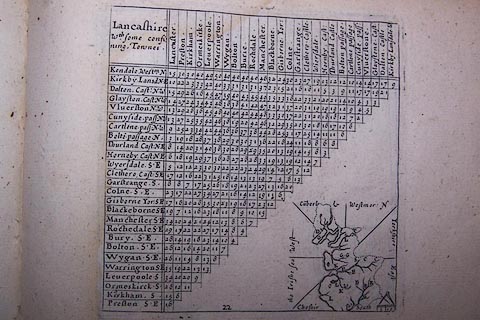 click to enlarge
click to enlargeSIM522.jpg
L on thumbnail map?
item:- private collection : 50.22
Image © see bottom of page
 goto source
goto sourcePage 39:- "..."
"... Brave John a Gant's old Town-a:"
"A Seat anciently renowned,"
"But with store of Beggars crowned;"
"For a Gaoler ripe and mellow,"
"The World has not such a Fellow."
placename:- Lancaster
page 18; describing plate 38 "The Continuation of the Road from / LONDON to CARLISLE in Cumberland."
"... ent'ring Lancaster at 232'4 on the S-side of Lunn flv. a Place of good Antiquity, suppos'd to be the Longovicum in the Notitia's, containing several handsom Streets, with a large Ch. which together with the Castle, where are kept the general Assizes and County-
"Thence pass the River over a Fair Stone-Br. at 235'7 to ..."
item:- private collection : 367
Image © see bottom of page
placename:- Lancaster
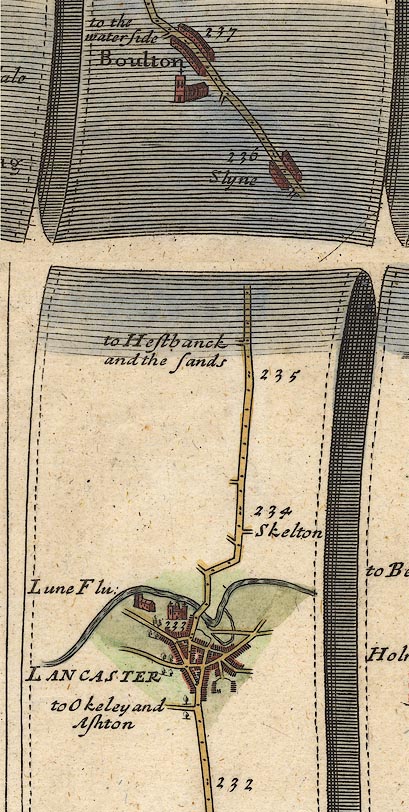
OG38m232.jpg
In mile 232, Lancashire. "LANCASTER"
town plan, with castle and church, the river on the further side (north).
item:- JandMN : 21
Image © see bottom of page
placename:- Lancaster
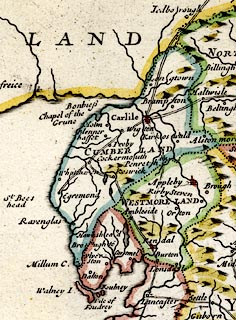 click to enlarge
click to enlargeMRD3Cm.jpg
"Lancaster"
circle, buildings and tower; town
item:- JandMN : 339
Image © see bottom of page
item:- fish; salmon; salmon wier
"The situation of Lancaster town is very good, the Church neately built of stone, the Castle which is just by, both on a very great ascent from the rest of the town and so is in open view, the town and river lying round it beneath; on the Castle tower walking quite round by the battlements I saw the whole town and river at a view, which runs almost quite round and returns againe by the town, and saw the sea beyond and the great high hills beyond that part of the sea which are in Wales, and also into Westmoreland to the great hills there call'd Furness Fells or Hills being a string of vast high hills together; also into Cumberland to the great hill called Black Comb Hill ... I also saw into Yorkshire; ..."
"Lancaster town is old and much decay'd; ... the town seemes not to be much in trade as some others, but the great store of fish makes them live plentifully as also the great plenty of all provisions; the streetes are some of them well pitch'd and of a good size; when I came into the town the stones were so slippery crossing some channells that my horse was quite down on his nose but did at length recover himself and so I was not thrown off or injured, which I desire to bless God for as for the many preservations I mett with - I cannot say the town seemes a lazy town and there are trades of all sorts, there is a large meeteing-house but their Minister was but a mean preacher: there are 2 Churches in the town which are pretty near each other."
placename:- Lancaster
placename:- Luguvicunt
item:- market
OGY7p072.txt
page 72
Distances from London "... ent'ring Lancaster at 231'4 on the S-side of Lunu flv. a Place of good Antiquity, suppos'd to be the Longovicunt in the Notitia's, containing several handsom Streets, with a large Ch. which together with the Castle, where are kept the general Assizes and County-Gaol, stand on the N.W. of the T. 'Tis a Corp. govern'd by a Mayor, 2 Bayliffs, 6 Mayor-Peers or Brethren, 24 Burgesses, &c. Statutes-Merchants are here acknowledged, and Parl-Men elected; This T. has a great Mt. on Saturd. for Corn, Cattel, Fish, (especially Salmon) and other Provisions; and has given Title of Earl and Duke to several Princes of the Royal Blood for some Centuries of Years."
"Thence pass the River over a Fair Stone-Br. at 235'7 ..."
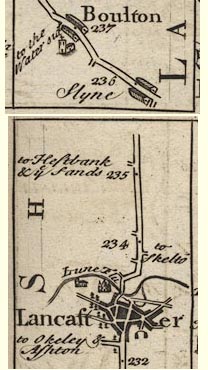
B093m232.jpg
item:- Dove Cottage : 2007.38.100
Image © see bottom of page
placename:- Lancaster
"... Lancaster is the next, the county town, and situate near the mouth of the River Lone or Lune. The town is antient; it lies, as it were, in its own ruins, and has little to recommend it but a decayed castle, and a more decayed port (for no ships of any considerable burthen); the bridge is handsome and strong, but, as before, here is little or no trade, and few people. ..."
placename:- Lancaster
placename:- Loncaster
placename:- Longovicum
item:-
The Bowen and Kitchin map of Lancashire has descriptive text:- "LANCASTER or Loncaster from the River Lone over which it has a fair Stone Bridge of 5 Arches. The present Name seems to point at the Old Longovicum, where a Company of the Longovii dwelt, and Coins have been dug up in the place where the Friery stood, where it is said the old Town was when destroyed by the Scots in 1322. The present Town was built near a green Hill and is now pretty large, containing several Streets & well built Houses, yet has but a Parish Church which is a large & handsome Structure on the side of a high Hill on the Top of which stands the Castle, now made use of for the County Prison, & where the Assizes are kept. 'Tis govern'd by a Mayor, Bailiffs, 12 Brethren, 24 Burgesses, 2 Chamberlains, a Recorder, Town Clerk, &c. Its Market is well supplied with Corn, Cattle & Fish especially Salmon. Mr. Camden says that in his time this Town was not populous, & that the Inhabitants were chiefly Husbandmen as lying in a good Soil; but 'tis very much improved since for 'tis at present a populous & thriving Corporation &a good Port."
placename:- Lancaster
placename:- Longovicum
placename:- Caer Werid
placename:- Green Town
item:- roman altar; altar, roman; roman potsherds; potsherds, roman; roman coin; coin, roman; charter; market charter; shipping
 goto source
goto sourcePage 13:- "LANCASTER [1]"
"THE castle here is the first object that attracts the attention of the curious traveller. ..."
"[1] (Longovicum, Notit, Imper.)"
 goto source
goto sourcePage 14:- "The town that Agricola found here, belonged to the western Brigantes, and in their language was called Caer Werid, i.e. the Green Town. The name is still retained in that part of the town called Green Aer, for Green Caer; the British construction being changed, and Werid translated into English."
"..."
 goto source
goto sourcePage 19:- "The Caledonians, the unconquered enemies and greatest plague of the Romans in Britain, were particularly galled and offended with the garrison at Lancaster, it being always the first to oppose them, as often as they invaded the empire, by crossing the Solway firth. ... and skulking along the Cumberland coast, they crossed the Morecambe-bay, and were first discovered on the banks of the Lune. Here they were opposed by the townsmen, who kept the garrison; and if they did not return by the way they came, the alarm brought upon them the garrisons of Overborough, Watercrook, and Ambleside, which surrounded and cut them off. Hence arose a particular hatred to the Lancastrians, which time and repeated injuries fomented into rage. In the end, the barbarous clans, following close upon the heels of the flying Romans, in a particular manner satiated their desire of revenge upon the helpless Lancastrians, by sacking and destroying their town and fortifications, in order that they might at no future time oppose their invasions. The"
 goto source
goto sourcePage 20:- "Saxons arriving soon after, raised on these ruins the town that remains to this day. Hence it may be inferred, that the present town of Lancaster stands on a magazine of Roman-British antiquities; and this is often verified by digging under ancient houses, where Roman remains are frequently found, and where it appears that the earth has been removed.- Beside what Dr. Leigh mentions, there are many recent instances that prove the conjecture."
"In the year 1772, in digging a cellar, where an old house had stood, in a street or lane, called Pudding-Lane (almost in the centre of the town) there was found [a roman altar],"
 goto source
goto sourcePage 21:- "..."
"A few years ago, in sinking a cellar in an old house in Church-street, great quantities of fragments of Roman earthenware were thrown out, urns, paterae, &c. many of them finely glazed, and elegantly marked with emblematic figures. Also some copper coins were found, ..."
 goto source
goto sourcePage 22:- "..."
"This town, ever since the conquest, has been renowned for loyalty and attachment to the established government; for which King John honoured it with as ample a charter as he had conferred on the burgess of Bristol and Northampton. Charles II. confirmed it with additional privileges. But Lancaster derived its greatest lustre and importance"
 goto source
goto sourcePage 23:- "from the title it gave to Edmund, second son of Henry III, and to his issue, Dukes of Lancaster, and Kings of England, of the Lancastrian line. In the end, however, it suffered much by supporting their title to the crown in the contest with the house of York. And so little had it retrieved itself when Camden visited it in 1609, that he speaks of it as not populous, and that the inhabitants were all husbandmen. Since that time it is, however, much enlarged [1]. The new houses are particularly neat and handsome; the streets are well paved, and thronged with inhabitants, busied in prosperous trade to the West Indies, and other places. Along a fine quay, noble warehouses are built. And when it shall please those concerned to deepen the shoals in the river, ships of great burthen may lie before them; for at present we only see, in that part of the river, such as do not exceed 250 tons."
"The air of Lancaster is salubrious, the environs pleasant, the inhabitants wealthy,"
"[1] The town has continued to increase. It has also been lately ornamented with a new town-hall, or exchange, esteemed a handsome building, with a noble portico. An elegant steeple has been also lately built to to (sic) the chapel (after the design of Mr. Harrison) by a donation of the late Mr. T. Bowes, which, with the turret on the exchange, add much to the pleasing or rather striking appearance this town has at a distance, on account of the castle, church, and the conspicuous situation of several good stone houses."
 goto source
goto sourcePage 24:- "courteous, hospitable, and polite."
"... There are also in this town, presbiterian, quaker, and methodist meeting houses, and a Romish chapel."
 goto source
goto sourceAddendum; Mr Gray's Journal, 1769
Page 216:- "[from the Burton road] ... Lancaster also appeared very conspicuous and fine; for its most distinguished features, the castle and church, mounted on a green eminence, were all that could be seen. Woe is me! when I got thither, it was the second day of the fair, the inn, in the principal street, was a great old gloomy house, full of people; but I found tolerable quarters, and even slept two nights in peace."
"In a fine afternoon I ascended the castle-hill; ... [viewed] the castle. Near it, and but a little lower, stands the church, ... From the church-yard there is an extensive sea-view, (for now the tide had almost covered the sands, and filled the river) and besides the greatest part of Furness, I could distinguish Peel-"
 goto source
goto sourcePage 217:- "[Peel-]castle on the isle of Foudry, which lies off its southern extremity. The town is built on the slope, and at the foot of the castle-hill, more than twice the bigness of Aukland, with many new buildings of neat white stone, but a little disorderly in their position, and 'ad libitum', like Kendal; many also extend below on the quays, by the river side, where a number of ships were moored, some of them three-masted vessels, decked out with their colours in honour of the fair. Here is a good bridge of four arches over the Lune, that runs, when the tide is out, in two steams, divided by a bed of gravel, which is not covered but in spring tides; below the town it widens to near the breadth of the Thames at London, and meets the sea at five or six miles distance to south-west."
placename:- Lancaster
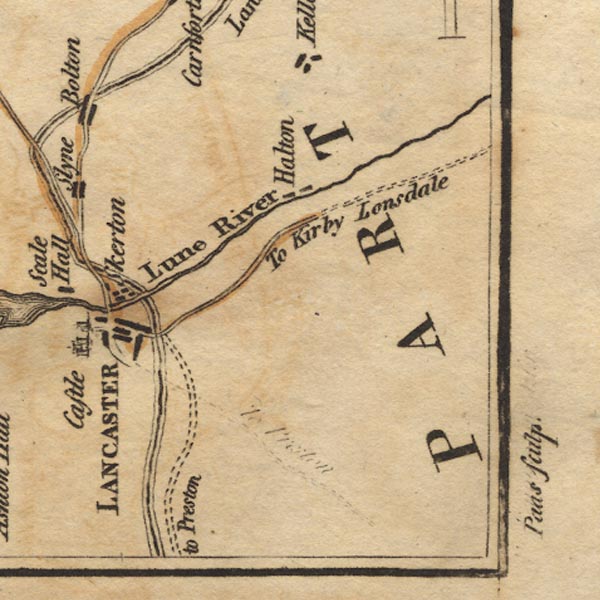
Ws02SD55.jpg
"LANCASTER"
As well as groups of blocks there are symbols for a church and the castle.
item:- Armitt Library : A1221.1
Image © see bottom of page
item:- roman coin; coin, roman; inscription, roman; roman inscription
 goto source
goto sourcePage 140:- ""... Lancaster (set on the south side of Lune) corruptly spoken for Lunecastre, 8 miles of, wither it ebbith and flowith. The ruines of old walls about the bridge were only of the suppressid priory. The castle on a hill strongly buildid and well repaired. The new town as they there say buildid hard by yn the descent from the castle, having one parish church, where sometime the priory of monks aliens was put down by king Henry V. and given to Syon abbey. The old wall of the circuit of the priory cometh almost to Lune bridge. Some have therby supposed that it was a piece of wall of the town. But indeed I espied in no place that the town was ever walled. The old town as they say there was almost all burned, and stood partly beyond the black friars. In those parts in the fields and foundations hath ben found"
 goto source
goto sourcePage 141:- ""much Roman coin. The soile about Lancaster is veri famous, plentiful of wood, pasture, meadow, and corn." The town hall is now rebuilding. ..."
"Dr. Leigh (III. 10.) mentions coins and fragments of earthen vessels, with inscriptions Julius Flavius and Regina I. and bones of animals found in a cellar there."
"In digging a cellar here 1772, was found the following inscription, now in the collection of sir Ashton Lever, bart. The stone is four feet on the longest, two feet 10 inches on the shortest side, and two feet six inches wide:DIS MANI
BVS
L IVL APOL
LINARIS
[T]REVIE R AN
XXX EQ AI [ ]
AE AI [ ]
I [V ]"
"On sinking the cellars for a large house at the upper part of Church street in this town built 1776 by the rev. Daniel Wilson, on the site of which stood some very old houses formerly used as the judge's lodgings, was discovered, at about six feet below the present surface of the street, supposed a Roman burying-place, as burnt wood, bones and ashes, broken paterae, urns, Roman brick, gutter tiles, coins, horns of animals, &c. were found; also, two fragments of thick wall, at about five yards distant from each other, in a direction from front to back, and seeming continued under Church-street, betwixt which were several large stones, some of them hewn. By this it may be conjectured to have been a vault to deposit the ashes of the dead, and to have fallen in, or been pulled down, as there were found, within the walls, several pieces of urns, an earthen sepulchral lamp entire (the end of the spout where the wick came out was burnt black), broken paterae, burnt bones, ashes, a large human skull, Roman coins, &c. also, at the north-end a well, filled with hewn stones, but not meddled with. There is a descent of about seventy or eighty yards from the back part of the house, to where is thought the river Lon anciently run, but now built upon. The ground on the said back part was levelled a great many yards, equal with the cellar floor; where also were found, from three to six feet deep according to the descent, burnt wood, bones, ashes, broken paterae, urns, other pieces of vessels of different shapes, Roman coins, boars' tusks, nails almost eaten with rust, pieces of lead, brass, &c. The stratum of ashes and bones was from a foot to about five feet thick. It no doubt runs quite under Church street, if not farther, as in digging a drain on the opposite side of Church street, and to the westward of Mr. Wilson's house, at about six feet under the surface, was found the same sort of stratum of ashes, bones, paterae, boars tusks, a small brazen head like a dog's, which by the appearance of the back part of it had been fixed to something; the pedestal and feet part of a small image, which seemed to be made of plaister of Paris or some such matter, and was thought to have been a [ ]lar, with an inscription; pieces of glass of a blueish-green colour, &c. One bottom of a patera had stamped on it CADGATEMA, perhaps the maker's name. These vessels are of a fine brown colour, far superior to the Staffordshire brown ware, elegantly varnished or glazed, some plain, others finely embossed with different sorts of figures, animals, and birds. The urns are of a coarse kind, much like the oil jars; and some of a black colour as if burnt in the fire, some small and some very large; but none entire, being broken into several pieces. Some have large handles."
"Nothing Roman was found above the burnt strata of ashes, bones, &c. which it may be conjectured was the then surface of the ground; and where the funeral rites were performed the burnt bones and ashes of the persons might be buried under this strata, as they were found in that situation with the pieces of urns. The inscriptions on the coins were none of them perfect, except one of brass, of Marcus Aurelius; and another small one of silver, a fine impression, and in high preservation,of Faustina his wife: on the head side, DIVA FAUSTINA PIA; reverse, a monument, with CONSECRATIO. The burying place is a little to the eastward, and without the wall of the Roman fortification where the garrison was kept, as there now remain several vestiges of the wall, sufficient to evince that it has taken up great part of the hill where the church and castle stands, and part of the upper end of Church-street. About 100 yards to the eastward of Mr. Wilson's new house, on the opposite side of Church-street, on digging a new cellar a few years ago for Mr, Henry Baynes's new house, were found several large hewn stones, and one about six feet under the surface, supposed to be about three ton weight, of which several cellar steps were made; and about a ton weight still remains in its place, under which were found a great many Roman coins of Domitian, Vespasian, &c. It is thought to have been the corner stone of a temple or other public building. There were found in Mr. Wilson's cellar, as also in the drain in Church-street, several stones, thought to have been pieces of small hand mill-stones, of about 13 inches diameter when whole, of a blueish-grey colour, and exceeding hard: they are about three inches thick at the outer edges, and not an inch in the middle."
"Here was a Benedictine priory, founded by Roger earl of Poictiers 1094, valued at £.80. given by Henry V. to Syon. An hospital founded by king John while earl of Moriton and by Henry duke of Lancaster t. Edward III. annexed to Seton priory, Cumberland. A house of Dominican or Black friars, founded by sir Hugh Harrington t. Henry III. What Mr. Camden takes for Roman wall called the Wery wall, is by Leland supposed part of the priory, but Mr. West contends for it being Roman. ..."
"The assizes for this county palatine are held in the castle which is entire and is the county gaol. The church stands near it on an eminence. Lancaster is a corporation and borough, and has a market and fair. The town is large and well-built though not regular: it has been much improved by widening and new building several streets, particularly a void place called the Green Air adjoining to the town is now covered with handsome houses,"
 goto source
goto sourcePage 142:- "and a new bridge built by act of parliament over the river Lune or Lon. It has a considerable trade particularly to the West-Indies, and a fine quay on the river Lune: the river navigable to the bridge for ships of 250 tons. The custom-house is a handsome building."
placename:- Loncaster
placename:- Loncastell
placename:- Longovicum
placename:- Caer Werid
placename:- Green City, The
placename:- Lancaster
placename:- Lunecastre
 goto source
goto sourcePage 131:- "..."
"The Lone proceeding a few miles further, sees on its south bank the chief town of the county, called more properly by the natives Loncaster, as also by the Scots, who gave it the name of Loncastell from the river Lone. Both the name and the river running by it prove it to be LONGOVICUM, where under the Dux Britaniarum, according to the Notitia, was stationed the Numerus Longovicariorum, who took their name from the place. Though it be at present but thinly peopled, and all the inhabitants farmers (the country about it being cultivated, open, flourishing and not bare of wood,) in proof of its Roman antiquity they sometimes find coins of emperors, especially at the friery. For that is said to be the site of the antient city, which the Scots burnt, after laying waste all before them in a sudden inroad A.D. 1322. From that time they began to build nearer the green hill on the river, on which stands a castle of no great size or antiquity, but handsome and strong: and by it on the same hill is the only church where formerly some alien monks had a house. Below this at the beautiful bridge over the Lone on the steep of the hill hangs a piece of very old wall of Roman work, called the Wery wall, from the later British name of this town as it should seem. For the Britans called this town Caer Werid or the Green City, perhaps from that green hill; but this I leave to others. John lord of Moriton and Lancaster, afterwards king of England, "confirmed to his burgesses of Lancaster by charter all the liberties that he had granted to the burgesses of Bristol;" and Edward III. a.r. 36, "granted to the mayor and baillifs of the town of Lancaster that the pleas and sessions should be holden no where else." Lancaster stands in N. latitude 54° 5′ and in W longitude 20° 48′."
placename:- Lancaster
 goto source
goto source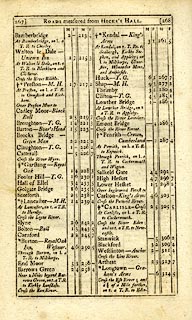 click to enlarge
click to enlargeC38267.jpg
page 267-268 "Lancaster - M.H. / At Lancaster, on r. a T.R. to Hornby."
market town, post office, market hall
 goto source
goto source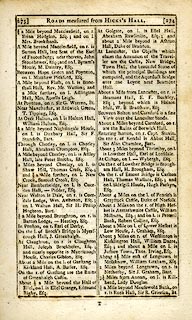 click to enlarge
click to enlargeC38273.jpg
page 273-274 "At Lancaster, the Objects which claim the attention of the Traveller are the Castle, New Bridge, Town Hall, the beautiful Stone of which the principal Buildings are composed, and the Aqueduct Bridge over the Loyne near Beaumont Hall."
 goto source
goto source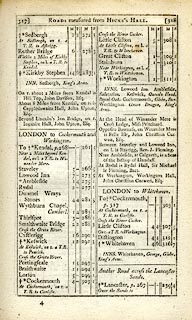 click to enlarge
click to enlargeC38317.jpg
page 317-318 "Lancaster, p.267"
market town, post office
item:- JandMN : 228.1
Image © see bottom of page
placename:- Lancaster
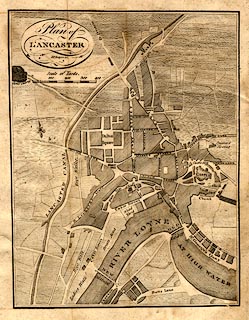 click to enlarge
click to enlargeHM07.jpg
Map, uncoloured engraving, Plan of Lancaster, scale about 5.5 inches to 1 mile, engraved by McIntyre, published by F Jollie, Carlisle, Cumberland, 1800.
Taken from a guide book, A Descriptive Tour, and Guide to the Lakes, Caves and Mountains, by John Housman, 1800, 5th edn 1812.
printed at oval cartouche, upper left:- "Plan of / LANCASTER / McIntyre sc."
printed at with scale line:- "Scale of Yards."
item:- JandMN : 233.10
Image © see bottom of page
placename:- Lancaster
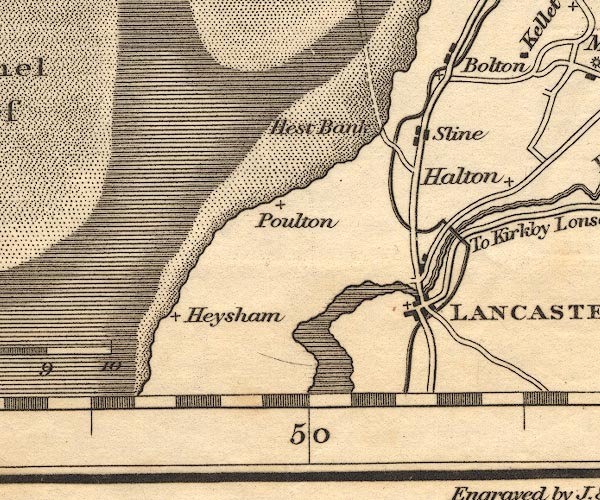
OT02SD46.jpg
"LANCASTER"
item:- JandMN : 48.1
Image © see bottom of page
placename:- Longovicus
placename:- Setantiorum Portus
 goto source
goto source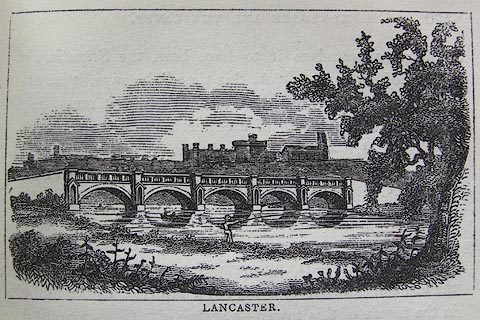 click to enlarge
click to enlargeO80E30.jpg
"LANCASTER."
item:- Armitt Library : A1180.30
Image © see bottom of page "LANCASTER.- Dr. Whittaker, the eminent topographer and antiquarian, pronounces Lancaster to be 'a highly favoured place, distinguished by the beauty of its situation, the magnificence of its Castle, and its rank as the capital of one of the most populous counties in the kingdom.' The complaisance of antiquarians, led by their father, Camden, has generally induced them to consider this place as the Longovicus of the Notitiae; but"
 goto source
goto sourcePage 170:- "Whittaker conceives it to have been the Setantiorum Portus of Ptolemy. 'At this time,' he says. 'an attentive eye will scarcely discover, in the oldest remaining buildings, any vestiges of architecture prior to the time of Charles II.'"
item:- latitude; longitude; lat and long
 goto source
goto sourcePage 79:- "STATION IV.- CONISTON OLD MAN."
"Latitude 54° 22′ 20″ N. Longitude 3° 6′ 34″W. Height 2577 feet."
 goto source
goto sourcePage 92:- "LANCASTER"
"Is a well-built town, containing 12,613 inhabitants. It is a sea-port upon the Lune, over which there is a handsome bridge; and about a mile further up a grand aqueduct, by which the Canal is conducted across the river."
"The Castle, including the county jail and spacious halls for the administration of justice, occupies a commanding situation. ... An ancient Church with a lofty tower stands upon the same eminence. The King's Arms, Royal Oak, and Commercial, are the principal inns."
"A quick sailing Packet Boat, for the conveyance of passengers, has lately been established, every day, between Preston and Kendal, through Lancaster."
| BEARINGS | Distances in miles |
Height in feet |
|
| Lancaster | 31 SE | 25 |
placename:- Lancaster
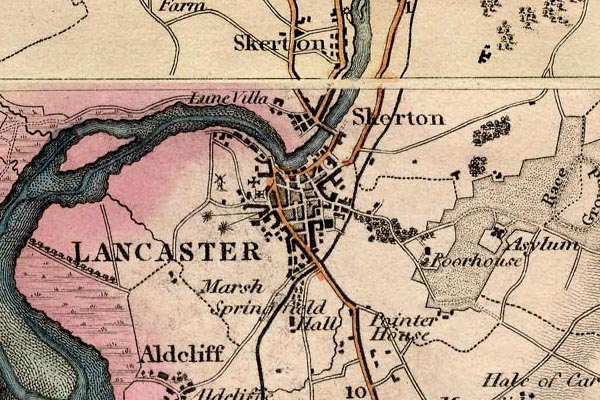
grw6lncs.jpg
"LANCASTER"
street map; labelled in block caps for a market town; two stars for members sent to Parliament.
item:- Armitt Library : A1824
Image © see bottom of page
placename:- Lancaster
item:- population, Lancaster; market day; fair
 goto source
goto source"..."
"THE order in which the Lakes should be visited, if seen in any prescribed order at all, can be pointed out much more easily than satisfactorily. Lancaster and Kendal in the south, Carlisle and Penrith in the north, formerly offered the readiest facilities of access to this Northern Elysium; but since the improvement of steam navigation, Whitehaven and other ports have become equally suitable as starting places. One advantage, however, remains in favour of the old routes, that the direct lines are better, especially for carriages, although to the pedestrian this will not be a matter of any great importance."
"Since the greatest influx of tourists is from the south of England, and the Lancashire Lakes are best approached from that quarter, it may not be"
 goto source
goto sourcePage 2:- "improper to commence our description, by entering into the district from Lancaster."
"LANCASTER"
"Will, without doubt, excite the curiosity and admiration of the tourist. The massive towers of the castle proudly overlooking the town - the church - the sessions-hall - and noble bridge crossing the Lune - will by turns engage the attention; and the beautiful prospects which embrace the town, the river, and the sea, will give him a rich foretaste of the enjoyment awaiting him amid the blue highlands which close in the distance."
 goto source
goto sourcePage 151:- "..."
"LANCASTER is an ancient town, and the capital of the county-palatine of Lancaster, beautifully situated on a hill above the river Lune, which falls into Morecambe Bay, at the distance of seven miles. On the summit of the hill is the Castle, ... The principal public buildings, in and near the town, are the Town-hall, in the market-place, the Custom-house, the Assembly-room, the Theatre, and the county Lunatic Asylum, which is capable of accommodating 300 patients, is perfectly secure, and conducted on an excellent plan."
 goto source
goto sourcePage 152:- "The trade of Lancaster is very considerable, not only at Glasson Dock, where the larger ships generally unload but also at the Canal, which is one of very great extent, and connected with many of the principal towns in the manufacturing districts. Fairs for the sale of cheese are held here twice a-year, at which immense quantities are sold. Lancaster is incorporated under a mayor, aldermen, &c., and sends two members to Parliament. Population, 12,613; market-days, Wednesday and Saturday; inns, King's Arms and Royal Oak."
placename:- Lancaster

FD02SD46.jpg
"LANCASTER"
item:- JandMN : 100.1
Image © see bottom of page
placename:-
"... At Lancaster we are at the mouth of the Lune, which must be crossed by Skerton Bridge on leaving the town"
placename:- Lancaster
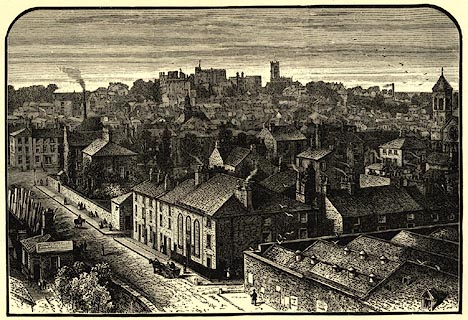 click to enlarge
click to enlargePR0567.jpg
printed at bottom:- "LANCASTER."
item:- Dove Cottage : 2008.107.515
Image © see bottom of page
placename:- Lancaster
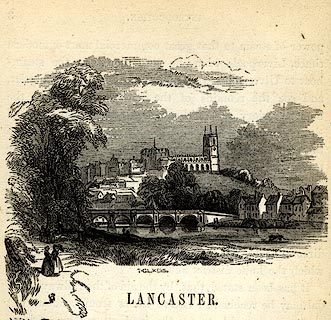 click to enlarge
click to enlargeSYL102.jpg
On p.4 of Sylvan's Pictorial Guide to the English Lakes.
printed at bottom:- "T. GILKS [ ]"
item:- Armitt Library : A1201.2
Image © see bottom of page
